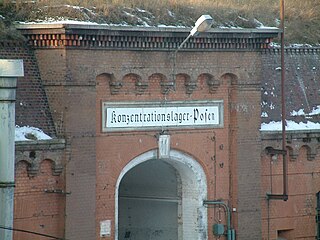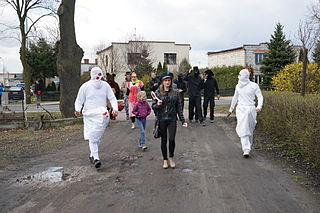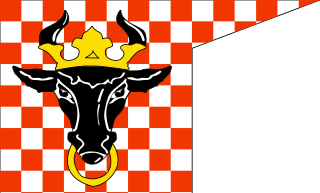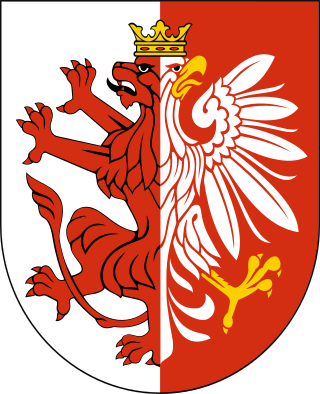
The Province of Posen was a province of the Kingdom of Prussia from 1848 to 1920, occupying most of the historical Greater Poland. The province was established following the Poznań Uprising of 1848 as a successor to the Grand Duchy of Posen, which in turn was annexed by Prussia in 1815 from Duchy of Warsaw. It became part of the German Empire in 1871. After World War I, Posen was briefly part of the Free State of Prussia within Weimar Germany, but was dissolved in 1920 when the Greater Poland Uprising broke out and most of its territory was incorporated into the Second Polish Republic. The remaining German territory was re-organized into Posen-West Prussia in 1922.

Masovians, also spelled as Mazovians, and historically known as Masurians, is an ethnographic group of Polish people that originates from the region of Masovia, located mostly within borders of the Masovian Voivodeship, Poland. They speak the Masovian dialect of Polish.

Kuyavians is an ethnographic group of Polish people, that originate from the region of Kuyavia, located within the Kuyavian-Pomeranian Voivodeship and eastern Greater Poland Voivodeship in Poland. They speak the Kuyavian subdialect of the Greater Poland dialect cluster of Polish language. The group itself been influenced by nearby groups of Pomeranians and Greater Poland people.
Andrzej Sakson is a Polish sociologist and historian. Since 2004 he has been the director of the Western Institute in Poznań.

Greater Poland uprising of 1806 was a Polish military insurrection which occurred in the region of Wielkopolska, also known as Greater Poland, against the occupying Prussian forces after the Partitions of the Polish–Lithuanian Commonwealth (1772–1795).

Fort VII, officially Konzentrationslager Posen, was a Nazi German death camp set up in Poznań in German-occupied Poland during World War II, located in one of the 19th-century forts circling the city. According to different estimates, between 4,500 and 20,000 people, mostly Poles from Poznań and the surrounding region, died while imprisoned at the camp.

The Expulsion of Poles by Nazi Germany during World War II was a massive operation consisting of the forced resettlement of over 1.7 million Poles from the territories of German-occupied Poland, with the aim of their Germanization between 1939 and 1944.

Greater Poland, often known by its Polish name Wielkopolska, is a Polish historical region of west-central Poland. Its chief and largest city is Poznań followed by Kalisz, the oldest city in Poland.

Siwki or Siwek is a regional tradition rooted in Polish folklore, in which a procession of dressed up individuals stops passers-by and performs tricks on them. The event usually takes place on Easter Sunday or Easter Monday.

Greater Poland Province was an administrative division of the Crown of the Kingdom of Poland from 1569 until 1795. The name of the province comes from the historic land of Greater Poland.

The Duchy of Kalisz was a feudal district duchy in the Greater Poland, centered on the Kalisz Region. Its capital was Kalisz. The state was established in 1177, in the partition of the Duchy of Greater Poland, after the rebellion against Mieszko III. Duke Casimir II the Just of the Piast dynasty become its first ruler. It existed until 1279, when, it got united with duchies of Gniezno and Poznań, under the rule of Przemysł II, forming the Duchy of Greater Poland. It remained a fiefdom within the Duchy of Poland, until 1227, and after that, it become an independent state.

Greater Poland people is a collection of the ethnographic groups of Polish people, that originate from the region of Greater Poland.
The Borderlands Poles, also known as the Borderlands groups, is a term for the collection of the ethnographic groups of Polish people from the area of the Eastern Borderlands, an area to the east of modern borders of Poland, within the modern territory of Belarus, Lithuania, Ukraine. They are mostly descendants of Masovians, and to lesser extend, Lesser Poland people, who colonized the area across centuries. The groups aren't directly connected, having different origins, and developing separately. However, they are categorized together, due to the shared factor of devolving on the eastern boundaries of Polish population, influenced by the other ethnic groups located to the east. In the aftermath of World War II, they were displaced from the Soviet Union to Poland, mostly in the first repatriation of 1944–1946, and later in the second repatriation of 1955–1959. As such, they, and their descendants, now live across Poland. Such people are also known as the Bug River Poles.
The Lesser Poland people is a collection of the ethnographic groups of Polish people, that originate from the region of Lesser Poland. They speak in the Lesser Poland dialect of Polish language.
Taśtaks is an ethnographic group of Polish people, and part of the bigger ethnographic group of the Greater Poland people. They inhabit the rural area around the Warta river near the Nowe Miasto nad Wartą, in the counties of Środa and Września, in the Greater Poland Voivodeship, Poland, notably including the villages of Czeszewo, Krzykosy, Lubrze, Orzechowo, Pięczkowo, and Witowo.

Łowiczans, also known as the Łowicz Dukes, is an ethnographic group of Polish people, that are part of the ethnographic subgroup of Masovians. They originate from the north west Masovia, located within borders of the Masovian Voivodeship, Poland. The group speak in the Łowicz subdialect of the Masovian dialect of Polish.
Poborzans, also spelled as Pobożans, are an ethnographic group of Polish people, that are part of the ethnographic subgroup of Masovians. They originate from the north west Masovia, located within the region of Poborze and Zawkrze, to the north of Mława river. The group is descendant of the Polish nobility that had inhabit the area in the Late Middle Ages. They are culturally separate from the neighbouring groups.

Łęczycans is an ethnographic group of Polish people that originate from the historical region of Łęczyca Land, located within borders of the Łódź Voivodeship, Poland. The group currently does not express much cultural separateness from other Poles. Historically, the group has been heavily inflected by the neighboring groups of Masovians, Greater Poland people, and Lesser Poland people.

Sieradzans is an ethnographic group of Polish people that originate from the historical region of Sieradz Land, located within borders of the Łódź Voivodeship, Poland. The group does not express much cultural separateness from other Poles. Historically, the group has been heavily inflected by the neighboring groups of Silesians, Greater Poland people, and Lesser Poland people.
Kuyavian Borowiaks is an ethnic subgroup of Kuyavians, who themselves are an ethnographic group of Polish people. They originate from the forest area of southern Kuyavia, located between the towns of Brdów, Przedecz, and Sompolno, within the counties of Koło and Konin, within the Greater Poland Voivodeship, Poland. They speak the Kuyavian subdialect of the Greater Poland dialect of Polish language. The group itself has inflected by nearby groups of Kashubians and Greater Poland people.
















